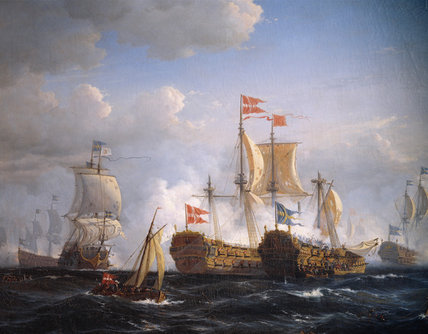Flyvende Ulv (Flying Wolf)
The Flyvende Ulv was a Danish merchantman part of the Dansk Østindisk Kompagni (Danish East India Company). She began her life as merchant vessel for the Swedish, having been built for that purpose in 1670, with the name Flygande Vargen (Flying Wolf). 120 ft length in length 27ft across the beam and a draft of 12 ft 3 inches. She displaced 250 Swedish læsts, a unit of bulk or weight which had differing values; in the late 17th century a læst roughly equated to 1.9 tons burden (1).
In 1675 she was hired into naval service and was converted into a warship to help in the Skånian War (1675-79) a Danish/Swedish conflict. She is said to have been present at the Battles of Bornholm (25/05/1676) and Öland (01/06/1676) (2). On July 1st 1677 the Flygande Vargen was part Swedish force that would engage the Danish in the Battle of Køge bay. A superior Swedish Fleet consisting of 18 men-of-war, 12 Frigates, 6 Fireships and 11 smaller vessels faced off against a smaller Danish Fleet; of 16 men-of-war, 9 Frigates, 2 fireships and 7 other vessels (3). The Danish Navy, under command of Admiral Neils Juel scored a tremendous victory, after 10 hours of fighting the Swedish were force to with draw having lost 8 vessels; with the Danish not registering the loss of even one ship. Amongst the captured was the Flygande Vargen, taken by the 32 gun frigate Charitas; ironically also a Swedish prize (1).
She was captured with 4 bronze and 50 iron cannon. Her prize money was 921 Rigsdaler, 2 marks shilling for the bronze cannon and 1,979 rigsdaler, 4 marks, 2 shilling for the iron cannon (1). It is noted that the 10% prize money offered to the capture of Swedish vessels could not be met in cash by King Christian V, and instead Admiral Juel was sold some of the Crown estate and Valdemars Castle on Tåsinge, which is still owned by his family today (4).
In 1681, for a fee of 14,000 rigsdaler, the Danish Navy, allowed the now Flyvende Ulv, to be taken on a journey to India by the Dansk Østindisk Kompagni. She received her pass on the 22nd October 1681 and left Copenhagen under command of Capt J Emmerick for Tranquebar. At this time the vessel is listed as carrying only 32 guns and 210 men (5). She returned with a cargo of tea and other goods on the 4th July 1683. In 1685 the King gave the deed of the vessel to the Dansk Østindisk Kompagni, and shortly after she set sail again.
The Ulv would leave Denmark for the last time on the 27th March 1689. Having had to delay her February departure due to being frozen in, she finally departed alongside the Flyvende Hjort and Antoinette. The voyage was a fraught affair, losing 79 men before the 24th December after exploring the coast of Angola and St Helena, and by the time she reached Nagapatam on the 22nd April 1690, 97 were dead in a voyage that had taken 14 months. Her return journey would be equally eventful.
On the 30th September 1690 Moritz Hartmann took took control of the vessel for the return. Hartmann had been made governor of Tranquebar, a danish colony, by the Dansk Østindisk Kompagni; overseeing several treaties and reforms during his six month stay (6). Now alongside the Flyvende Hjort, the journey home began in earnest, however by the 5th October a leak forced the Ulv to seek repairs. The Hjort was ordered to dock until the Ulv returned. The Ulv arrived in Malakka on the 28th October, where they found the damage to be more considerable than thought, she continued on to Batavia reaching it on the 20th November; where it took a month to finalise her repairs. During the homeward voyage Hartmann was known to have been hard on the crew, going so far as to execute the chief officer for insubordination.
There is little known about the loss of the Flyvende Ulv, a report on the London Gazette records the news from Plymouth that on "this day [18th October] we have advice from Loo that a great Danish East India Ship, homeward bound, was cast away last night near that place. She had been out 3 years and was very rich"(7). King Christian noted in his diary that on the 6th November that the Ulv was lost in the Channel near Plymouth, with the crew and part of the cargo salvaged (6). An order was later sent to the commisioners of customs, via King William, noting that the King of Denmark was aware that the ship had gone down near Plymouth and that the officers of that place 'take care that the goods which have been saved of the said ship, be not embezelled' until the King could send a ship from Denmark to collect them (8).
Images
Battle of Køge Bay, July 1 1677, Denmark
|
References
(1) http://www.milhist.dk/svenske_krigene/skibstab_skaane/skibstab_skaane.htm
(2) http://threedecks.org/index.php?display_type=show_ship&id=18897
(3) http://www.navalhistory.dk/english/history/navybefore1801.htm
(4) http://www.valdemarsslot.dk/87-the-battle-in-k%C3%B8ge-bay.html
(5) http://ddd.dda.dk/dop/visning_billed.asp?id=1772&sort=e
(6) http://www.denstoredanske.dk/Dansk_Biografisk_Leksikon/Forsvar_og_politi/S%C3%B8officer/Moritz_Hartmann
(7) London Gazette, London, England, 22 October 1691, Issue 2707
(8) 'William and Mary: November 1691', Calendar of State Papers Domestic: William and Mary, 1691-2, pp 1-21, URL: http://www.british-history.ac.uk

